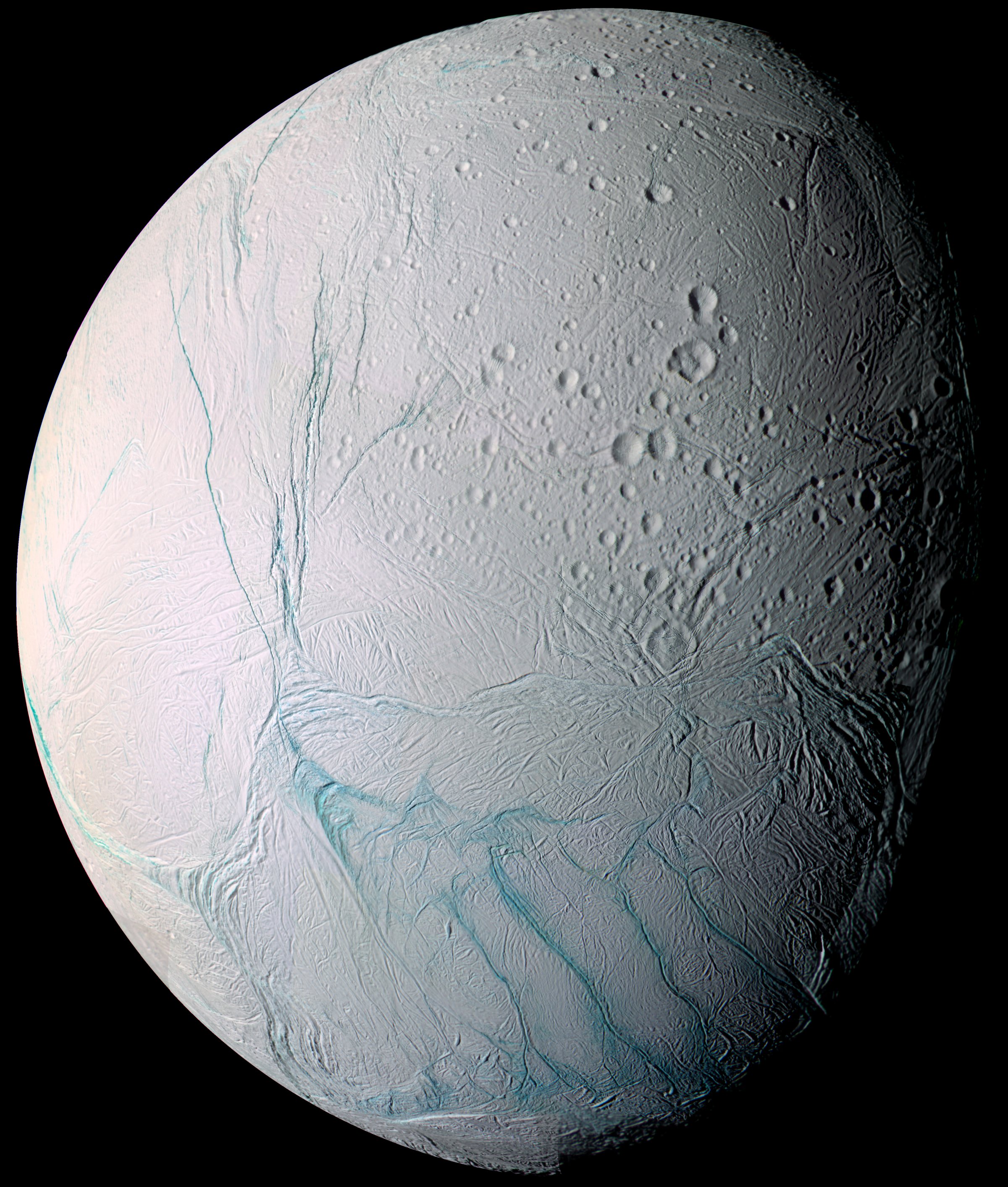
When the Cassini spacecraft got its first closeup look at Saturn’s moon Enceladus after the probe’s arrival in 2004, it was rewarded with a jaw-dropping sight: gigantic geysers of ice particles and water vapor spewing hundreds of miles into space from the icy world’s southern hemisphere. These plumes are so prolific that they continuously resurface Enceladus’ sparkling white surface with a fresh coating of ice crystals—and still have enough left over to be the main source of ice particles that make up Saturn’s E-ring.
It hasn’t been entirely clear where the geysers come from, however. Circumstantial evidence points to a subsurface ocean—the ice, as Cassini found by flying through the plumes, is laced with salts, suggesting a body of water in constant contact with a rocky bottom. It’s not crazy to imagine such an ocean, either: the constant flexing Enceladus feels from tidal forces caused by Saturn’s gravity would keep the moon’s core warm, melting what would otherwise be a solid coating of ice from below. That’s just what scientists see on Jupiter’s moon Europa—which appears to have its own, albeit less prominent, plumes of water vapor.
But a new paper in Science has turned “not crazy” to “almost certainly true.” By measuring subtle distortions in Enceladus’ gravitational pull as Cassini whips past different regions of the moon, planetary scientists have found a slight excess of gravity in the moon’s southern hemisphere—and a large underground body of water is exactly what would produce that kind of measurement. “It wasn’t a surprise to find a water reservoir,” said lead author Luciano Iess, of the Sapienza Universita di Roma, in Italy, at a press conference. But its size and extent, he said, were unknown.
Not any more: Cassini’s readings show that Enceladus’ buried sea, which lies some 30 miles (48 km) beneath the surface of the 500-mile-diamater (804 km) moon, is at least several miles deep. “It’s deepest near the south pole,” said co-author David Stevenson, a planetary scientists at Caltech, “and it appears to extend at least halfway to the equator in all directions.” It might even span the entire moon, said Iess. “Our data neither exclude nor confirm a global ocean, or whether there are other water pockets.” But at the very least, said Stevenson, “It contains as much or more water than Lake Superior.”
That’s a big deal, and not just because the idea of liquid water so far from the Sun’s warming rays would have been considered absurd a few decades ago. Scientists who speculate about life beyond Earth have long been convinced that water is a basic requirement for biology—and along with Jupiter’s moons Callisto, Europa and Ganymede, and Saturn’s Titan, this makes five places in the Solar System’s frigid regions where life could plausibly exist.
Water alone isn’t enough, of course: life as we know it is built out of complex carbon-based molecules, and without those you’re out of luck. But the same flybys that detected salts in Enceladus’ plumes also found traces of methane and carbon dioxide. These molecules are too simple to qualify as evidence for life by themselves, but, said Cornell’s Jonathan Lunine, who wasn’t involved with the research, “taken all together, the water, salts and organic molecules make the interior of Enceladus a very attractive potential place for life.”
In fact, says planetary scientist Kevin Hand, of NASA’s Jet Propulsion Laboratory, the discovery of life here, should it ever happen, might be an even bigger deal than finding life on Mars. The reason: Mars and Earth are close enough together that asteroid impacts have blasted rocks from one planet to the other many times in the history of the Solar System. If life arose on Earth, it could have hitched a ride over to Mars inside a meteorite and infected our sister world—and it could have happened in the opposite direction as well.
That being the case, if we should find DNA-based life on Mars, it wouldn’t necessarily be clear that life arose independently. “For me,” says Hand, “finding a second origin of life is absolutely crucial. When we find a second origin in our solar system, then we can then think about exoplanets and say, ‘Okay, we know that if the conditions are right, life is likely to get started, and then it’s off to the races.’”
In order to find out for sure, we need to take a harder, closer look at these icy moons than any NASA probe has done to date. For his part, Hand has been involved in a potential mission called the Europa Clipper, while the European Space Agency is planning the Jupiter Icy Moons Explorer, currently slated for a 2022 launch.
Nobody’s planning a return to the Saturn system yet, but given the new, firm evidence of an ocean on Enceladus, it might be time to think about doing so. “Enceladus is a gem of the Saturnian system,” says Hand, “with many untold secrets that can only be answered by a new mission.”
The real trick, of course, will be getting Congress to pay for it.
More Must-Reads from TIME
- Cybersecurity Experts Are Sounding the Alarm on DOGE
- Meet the 2025 Women of the Year
- The Harsh Truth About Disability Inclusion
- Why Do More Young Adults Have Cancer?
- Colman Domingo Leads With Radical Love
- How to Get Better at Doing Things Alone
- Michelle Zauner Stares Down the Darkness
Contact us at letters@time.com